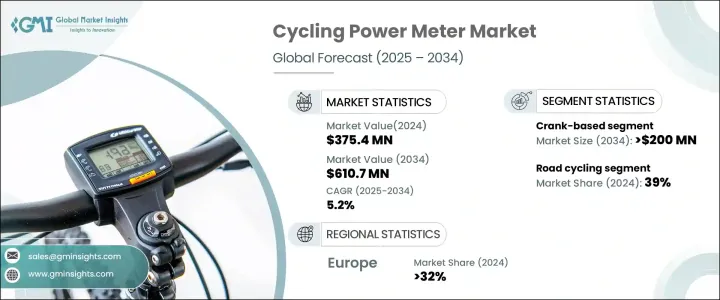
세계의 사이클링 파워 미터 시장은 2024년 3억 7,540만 달러에 달했고, 2025년부터 2034년까지 연평균 복합 성장률(CAGR) 5.2%로 성장할 것으로 예측됩니다.
자전거 커뮤니티에서 디지털 프레임워크와 데이터 구동 교육 기법의 채택이 증가함에 따라 자전거 전력계 수요가 크게 늘어나고 있습니다. 이러한 장치는 페달링 중에 사이클리스트가 발휘하는 힘을 측정하며 성능 향상에 필수적입니다. 경쟁 사이클링과 지구력 훈련의 인기가 증가함에 따라 라이더는 정확한 성능 추적 도구를 추구하고 교육 요법의 최대 효율을 보장합니다.

시장은 특히 스마트 트레이너, 인터넷에 연결된 자전거 플랫폼, 웨어러블 피트니스 장치 등의 기술 혁신이 급증하고 있습니다. 이러한 발전으로 사이클링 파워 미터와 다른 스마트 장비 간의 통합이 강화되고 원활한 트레이닝 생태계가 구축됩니다. 이 향상된 연결성을 통해 사이클리스트는 실시간 데이터를 분석하고 성능을 최적화하며 개선이 필요한 영역에 대한 귀중한 통찰력을 얻을 수 있습니다. 더 많은 사이클리스트들이 구조화된 교육 프로그램을 채택함에 따라 이러한 장비에 대한 수요가 증가할 것으로 보입니다.
| 시장 범위 | |
|---|---|
| 시작 연도 | 2024년 |
| 예측 연도 | 2025-2034년 |
| 시작 금액 | 3억 7,540만 달러 |
| 예측 금액 | 6억 1,070만 달러 |
| CAGR | 5.2% |
파워 미터 유형에 따라 시장은 페달 기반, 크랭크 기반, 허브 기반, 바텀 브라켓 등으로 구분됩니다. 2024년에는 크랭크 기반 부문이 시장의 31% 이상을 차지했으며 2034년에는 2억 달러 이상에 달할 것으로 예상됩니다. 크랭크 기반 파워 미터는 효과적인 교육에 필수적인 정확한 출력 측정이 가능하기 때문에 여전히 인기있는 옵션입니다. 자전거의 드라이브 트레인의 중심에 위치한이 미터는 다른 구성 요소와 비교적 독립적이지만 신뢰할 수 있는 데이터를 제공합니다. 로드 사이클리스트, 특히 전동 어시스트 자전거를 사용하는 사이클리스트는 크랭크 기반 파워 미터의 설계 혁신을 추진하고 시장에서 지속적인 우위를 확보하고 있습니다.
용도별로 시장은 로드 사이클링, 산악 자전거, 실내 훈련 등으로 분류됩니다. 로드 사이클링은 2024년 시장 점유율의 약 39%를 차지했습니다. 데이터 중심의 교육 방법이 강조되어 성능 최적화를 위해 사이클링 파워 미터에 대한 의존도가 높아지고 있습니다. 특히 경쟁 로드 사이클링은 정확한 페달 답력 측정을 제공하고 사이클리스트의 속도와 지구력을 향상시키는 데 도움이 되므로 이러한 장치에 대한 수요가 급증하고 있습니다. 아마추어와 전문 라이더는 마찬가지로 파워 미터를 훈련 효율성을 향상시키는 데 필수적인 도구로 생각합니다.
유럽은 2024년 32% 이상 시장 점유율로 세계 사이클링 파워 미터 시장을 선도하고 독일이 지역 수요의 상당 부분을 차지하고 있습니다. 독일의 견고한 사이클링 문화, 첨단 인프라 및 성능 기반 교육에 대한 관심 증가가 시장 확대에 기여하고 있습니다. 경쟁 사이클링 강국 중 하나인 독일은 프로 사이클리스트와 레크리에이션 사이클리스트의 인구가 많으며, 그들은 적극적으로 파워 미터를 사용하여 성능을 미세 조정하고 있습니다. 이 동향은 앞으로도 계속될 것으로 예상되며, 사이클링 파워 미터의 주요 시장으로서 유럽의 지위가 강화됩니다.
The Global Cycling Power Meter Market reached USD 375.4 million in 2024 and is expected to grow at a CAGR of 5.2% between 2025 and 2034. The increasing adoption of digital frameworks and data-driven training methodologies in the cycling community has significantly fueled the demand for cycling power meters. These devices measure the force exerted by a cyclist during pedaling, making them essential for performance enhancement. The growing popularity of competitive cycling and endurance training has pushed riders to seek precise performance-tracking tools, ensuring maximum efficiency in their training regimens.

The market has also witnessed a surge in innovations, particularly in smart trainers, internet-connected cycling platforms, and wearable fitness devices. These advancements have strengthened the integration of cycling power meters with other smart instruments, creating a seamless training ecosystem. This enhanced connectivity allows cyclists to analyze real-time data, optimize their performance, and gain valuable insights into areas that require improvement. As more cyclists embrace structured training programs, the demand for these devices is set to rise.
| Market Scope | |
|---|---|
| Start Year | 2024 |
| Forecast Year | 2025-2034 |
| Start Value | $375.4 Million |
| Forecast Value | $610.7 Million |
| CAGR | 5.2% |
Based on power meter type, the market is segmented into pedal-based, crank-based, hub-based, bottom bracket, and others. In 2024, the crank-based segment accounted for over 31% of the market and is expected to exceed USD 200 million by 2034. Crank-based power meters remain a popular choice due to their precise power output measurements, which are critical for effective training. Positioned at the heart of a bike's drivetrain, these meters provide reliable data while remaining relatively independent of other components. Roadside cyclists, particularly those using electric bicycles, have driven innovations in crank-based power meter design, ensuring their continued dominance in the market.
By application, the market is categorized into road cycling, mountain biking, indoor training, and others. Road cycling held approximately 39% of the market share in 2024. The growing emphasis on data-driven training methods has led to an increasing reliance on cycling power meters for performance optimization. Competitive road cycling, in particular, has seen a surge in demand for these devices as they offer precise pedal force measurements, helping cyclists enhance their speed and endurance. Amateur and professional riders alike consider power meters an essential tool for improving their training efficiency.
Europe led the global cycling power meter market with over 32% market share in 2024, with Germany holding a substantial portion of the regional demand. Germany's robust cycling culture, advanced infrastructure, and growing focus on performance-based training have contributed to market expansion. As one of the strongest countries in competitive cycling, Germany boasts a large population of both professional and recreational cyclists who actively use power meters to fine-tune their performance. This trend is expected to continue, reinforcing Europe's position as a key market for cycling power meters.